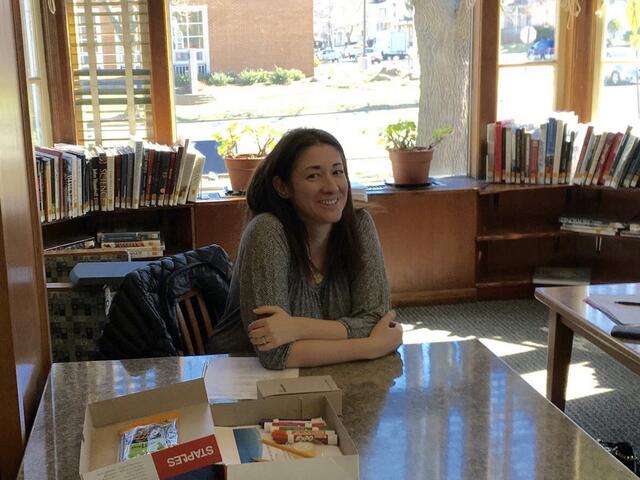Sheila Moreira joined the IRC in Elizabeth last fall and has hit the ground running in her work to better understand the current immigration crisis so that she can knowledgeably serve IRC clients. Earlier this year, Sheila visited San Diego and Tijuana to see first hand how humanitarian organizations, including the IRC, are working to serve asylum seekers at the border. Sheila reflects on her experience below.
This February, I had the opportunity to visit the Southern border with the IRC's national Immigration Director, Olga Byrne. I had originally reached out to Olga to inquire about taking a personal volunteer trip over a long weekend – to see if she had thoughts or suggestions. But instead, she proposed an official IRC trip and we traveled together to San Diego and Tijuana to volunteer and explore, to observe and serve as best we could. While Olga’s larger goal was to consider ways in which the important work being done on the ground at the border could be supported institutionally by our national network, my own bigger picture goals were more about how I could use the information I learned to better serve and advocate for our local immigrant communities in New Jersey. We see many of the asylum seekers who crossed the border end up in our state where they have joined their families or sponsors, awaiting their day in court. And of course, on a practical level, we were both eager to pull up our sleeves and put our Spanish-speaking skills and asylum law experience to good use during our time there.
On the Tijuana side, we worked with Al Otro Lado, a bi-national non-profit that provides direct legal services to indigent migrants, refugees, and deportees. Al Otro Lado is also a key player in litigation efforts currently challenging systemic human rights violations on the Southern border. We provided legal consultations to asylum-seekers preparing to present themselves at the San Ysidro Port of Entry. The varied and sometimes horrific stories we heard during these one-on-one interviews had one common thread: all the people we spoke to were fleeing violence. And, they had been scared enough to leave everything they knew behind. I held back tears listening to their reasons for leaving their homes, held and squeezed their hands to show support, explained the “credible fear interview” process and helped them zoom in on those parts of their stories that will be the key to allow them the opportunity to formally petition for asylum before an immigration judge.
While in Tijuana we also toured the plaza to observe “la lista” first hand; this is the informal migrant-maintained list of names which creates a virtual queue for those waiting to present themselves and request asylum from American immigration authorities. While we were there, Customs and Border Protection was calling about 40 names from that list each day at 7 am. Finally, on the Tijuana side we also visited an unaccompanied minor’s shelter called CASA INCA, whose objective is to support migrant youth and assist in reunifying them with family members. We toured the shelter and met and spoke with all of the children, who shared their thoughts on their own journeys with us and who appeared well cared for, well-informed of their rights and options, and both optimistic and realistic about their next steps.
On the San Diego side, we spent two days at a shelter that received asylum-seekers immediately after they were released from ICE custody. The operation, co-run by IRC, Catholic Charities, Jewish Family Services and ACLU ran like a well-oiled machine. From the moment migrants were dropped off by ICE at remote locations, a network of volunteers picked them up and brought them to the shelter where they were screened, and if necessary treated, by volunteer doctors and nurses. Then during intake we explained their immigration documents to them – their upcoming check-ins with ICE, their ‘TBD’ court dates, and the requirement to file an asylum application within one year – and reached out to their family members and sponsors to coordinate travel plans by plane, bus or pick-up. While they waited, they received a change of clothes, a shower, a meal and beds for resting; the children had a play area full of toys (which I saw volunteers clean and disinfect meticulously before new families arrived). Families stayed anywhere from a few hours to a few days at the shelter.
Seeing the nuts and bolts of the process at the border up close, just before asylum-seekers cross the border from Mexico and right after their release from detention in the U.S. was illuminating and will absolutely inform my legal work. But even more, my trip to the border has inspired a deeper admiration for these families fleeing persecution. The strength, determination and hope that propels migrants and refugees to survive, to thrive, and to protect and provide for their children is awe-inspiring. I left the border with a profound respect for the families and children I spoke to and an even clearer sense and conviction that the real “crisis” is our own country’s egregious derogation of legal and moral obligations to asylum seekers.

Sheila's exceptional dedication to those she serves through the IRC in Elizabeth's immigration program is both remarkable and admirable. Her broadened expertise through this trip has been of value not only to the immigration team, but for the IRC in Elizabeth's staff as a whole as the office continues to serve vulnerable immigrants in New Jersey. To support Sheila and her critical work, please visit here.
